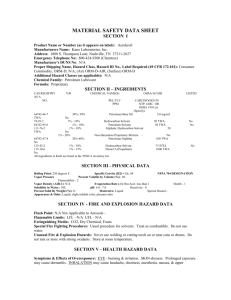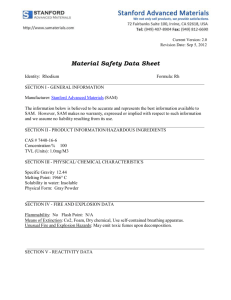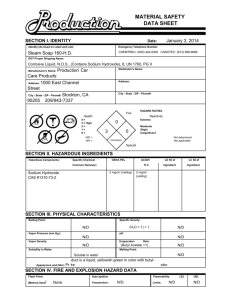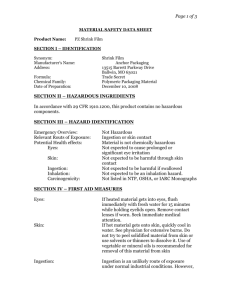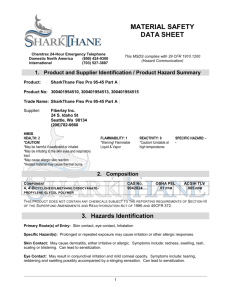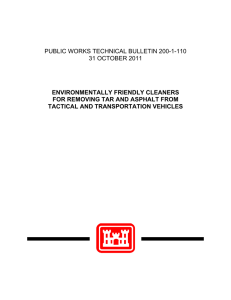MATERIAL SAFETY DATA SHEET
advertisement
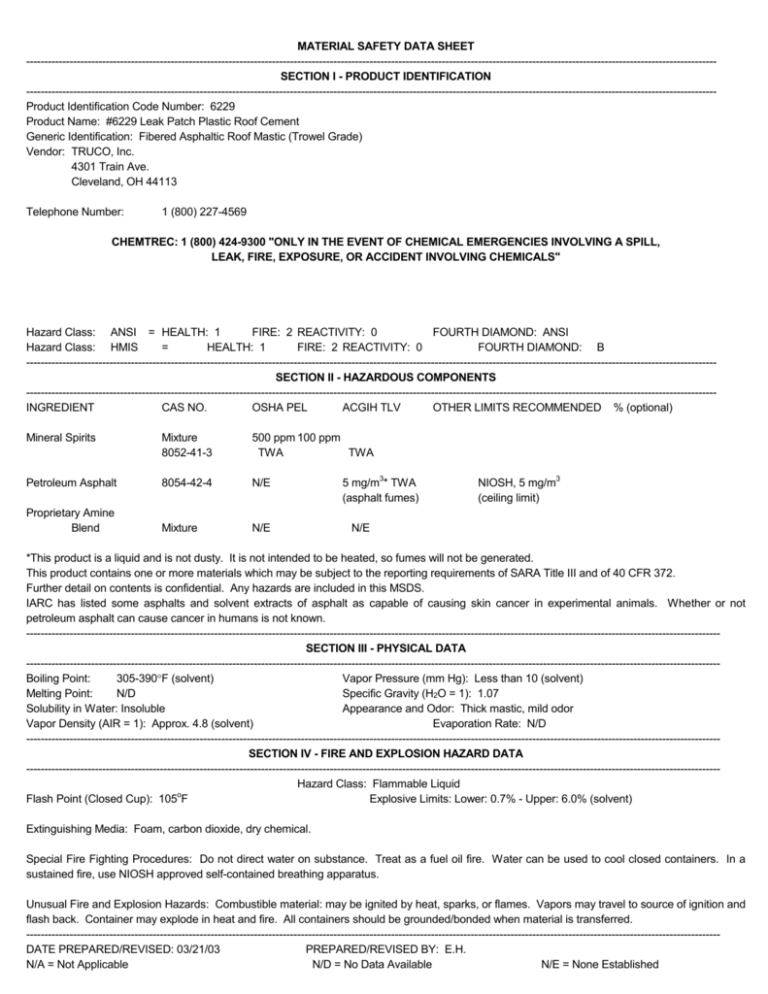
MATERIAL SAFETY DATA SHEET ----------------------------------------------------------------------------------------------------------------------------------------------------------------------------------------------SECTION I - PRODUCT IDENTIFICATION ----------------------------------------------------------------------------------------------------------------------------------------------------------------------------------------------Product Identification Code Number: 6229 Product Name: #6229 Leak Patch Plastic Roof Cement Generic Identification: Fibered Asphaltic Roof Mastic (Trowel Grade) Vendor: TRUCO, Inc. 4301 Train Ave. Cleveland, OH 44113 Telephone Number: 1 (800) 227-4569 CHEMTREC: 1 (800) 424-9300 "ONLY IN THE EVENT OF CHEMICAL EMERGENCIES INVOLVING A SPILL, LEAK, FIRE, EXPOSURE, OR ACCIDENT INVOLVING CHEMICALS" Hazard Class: ANSI = HEALTH: 1 FIRE: 2 REACTIVITY: 0 FOURTH DIAMOND: ANSI Hazard Class: HMIS = HEALTH: 1 FIRE: 2 REACTIVITY: 0 FOURTH DIAMOND: B ----------------------------------------------------------------------------------------------------------------------------------------------------------------------------------------------SECTION II - HAZARDOUS COMPONENTS ----------------------------------------------------------------------------------------------------------------------------------------------------------------------------------------------INGREDIENT CAS NO. OSHA PEL ACGIH TLV OTHER LIMITS RECOMMENDED % (optional) Mineral Spirits Mixture 8052-41-3 500 ppm 100 ppm TWA TWA Petroleum Asphalt 8054-42-4 N/E Proprietary Amine Blend Mixture N/E 3 5 mg/m * TWA (asphalt fumes) 3 NIOSH, 5 mg/m (ceiling limit) N/E *This product is a liquid and is not dusty. It is not intended to be heated, so fumes will not be generated. This product contains one or more materials which may be subject to the reporting requirements of SARA Title III and of 40 CFR 372. Further detail on contents is confidential. Any hazards are included in this MSDS. IARC has listed some asphalts and solvent extracts of asphalt as capable of causing skin cancer in experimental animals. Whether or not petroleum asphalt can cause cancer in humans is not known. -----------------------------------------------------------------------------------------------------------------------------------------------------------------------------------------------SECTION III - PHYSICAL DATA -----------------------------------------------------------------------------------------------------------------------------------------------------------------------------------------------Boiling Point: 305-390F (solvent) Vapor Pressure (mm Hg): Less than 10 (solvent) Melting Point: N/D Specific Gravity (H2O = 1): 1.07 Solubility in Water: Insoluble Appearance and Odor: Thick mastic, mild odor Vapor Density (AIR = 1): Approx. 4.8 (solvent) Evaporation Rate: N/D -----------------------------------------------------------------------------------------------------------------------------------------------------------------------------------------------SECTION IV - FIRE AND EXPLOSION HAZARD DATA -----------------------------------------------------------------------------------------------------------------------------------------------------------------------------------------------Hazard Class: Flammable Liquid o Flash Point (Closed Cup): 105 F Explosive Limits: Lower: 0.7% - Upper: 6.0% (solvent) Extinguishing Media: Foam, carbon dioxide, dry chemical. Special Fire Fighting Procedures: Do not direct water on substance. Treat as a fuel oil fire. Water can be used to cool closed containers. In a sustained fire, use NIOSH approved self-contained breathing apparatus. Unusual Fire and Explosion Hazards: Combustible material: may be ignited by heat, sparks, or flames. Vapors may travel to source of ignition and flash back. Container may explode in heat and fire. All containers should be grounded/bonded when material is transferred. -----------------------------------------------------------------------------------------------------------------------------------------------------------------------------------------------DATE PREPARED/REVISED: 03/21/03 PREPARED/REVISED BY: E.H. N/A = Not Applicable N/D = No Data Available N/E = None Established (page 2) 6229 ------------------------------------------------------------------------------------------------------------------------------------------------------------------------------------------SECTION V - REACTIVITY DATA ------------------------------------------------------------------------------------------------------------------------------------------------------------------------------------------Stability: Stable Hazardous Polymerization: Will not occur. Conditions to Avoid: N/E Hazardous Decomposition or Byproducts: Carbon monoxide, carbon dioxide, various hydrocarbon fragments. ------------------------------------------------------------------------------------------------------------------------------------------------------------------------------------------SECTION VI - HEALTH HAZARD DATA ------------------------------------------------------------------------------------------------------------------------------------------------------------------------------------------Route(s) of Entry: Inhalation? YES Skin? YES Ingestion? YES Eyes? YES Health Hazards (Acute and Chronic): Possible Irritant. Acute toxicity rating: 1-Possible slight, reversible w/in 7 days. Carcinogenicity: NTP? NO IARC Monographs? NO OSHA Regulated? NO Signs and Symptoms of Exposure: Exposure to material or vapor may cause irritation and/or redness to eyes, skin, and respiratory tract. Ingestion may cause irritation nausea and vomiting. Aspiration of material into lungs may cause chemical pneumonitis. Medical Conditions Generally Aggravated by Exposure: Preexisting eye, skin, respiratory disorders may be aggravated by exposure to this product. Emergency and First Air Procedures: Eye Contact: Flush with clean water for 15 min., seek medical attention. Skin Contact: Remove contaminated clothing, wash with soap and water. Inhalation: Remove victim to fresh air, if breathing is difficult administer oxygen, if breathing has stopped, administer artificial respiration. Seek medical attention. Ingestion: Do not induce vomiting. Contact poison control center, seek medical attention. ------------------------------------------------------------------------------------------------------------------------------------------------------------------------------------------SECTION VII - PRECAUTIONS FOR SAFE HANDLING AND USE ------------------------------------------------------------------------------------------------------------------------------------------------------------------------------------------Steps to be Taken in Case Material is Released or Spilled: Eliminate sources of iginition. Ventilate area if necessary. Dike and contain spill with inert material (e.g. clay, sand, earth). Prevent material from entering sewers or waterways. Recover free liquid. Transfer absorbed material into non-leaking, sealable containers for proper disposal. Waste Disposal Method: Dispose of in accordance with Federal, State, County, and Local regulations. Material is RCRA regulated waste. EPA hazardous waste number: D001 - Ignitable. Precautions in Handling and Storage: Keep away from sources of ignition. Use only with adequate ventilation. Avoid prolonged or repeated contact with skin. Follow "Special Protection Information". Other Precautions: Hazard Class...Combustible Liquid. KEEP OUT OF REACH OF CHILDREN ------------------------------------------------------------------------------------------------------------------------------------------------------------------------------------------SECTION VIII - CONTROL MEASURES ------------------------------------------------------------------------------------------------------------------------------------------------------------------------------------------Respiratory Protection: Normally not required in ventilated areas. If TLV is exceeded a NIOSH/MSHA approved breathing apparatus is recommended. (Contact safety equipment supplier) Ventilation: If current ventilation practices are not adequate to maintain airborne concentrations below the established exposure limits, additional ventilation or exhaust systems may be required. Protective Gloves: Solvent resistant gloves. Eye Protection: Wear safety glasses, chemical goggles, or face shield. Other Protective Clothing or Equipment: Long pants and long sleeved shirts are recommended to reduce material contact with skin. Shoes with non-skid soles are also recommended. Work/Hygienic Practices: Always follow good housekeeping practices. Avoid contact with surfaces where material will not be applied. ------------------------------------------------------------------------------------------------------------------------------------------------------------------------------------------INFORMATION PRESENTED HEREIN HAS BEEN COMPILED FROM SOURCES CONSIDERED TO BE RELIABLE AND IS ACCURATE AND RELIABLE TO THE BEST OF OUR KNOWLEDGE AND BELIEF BUT IS NOT GUARANTEED TO BE SO.
